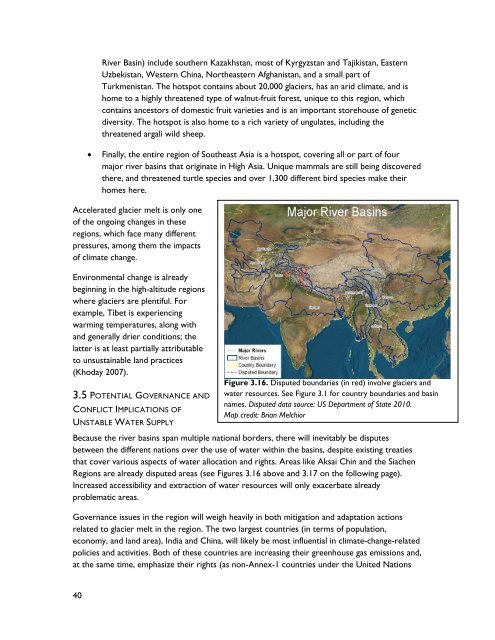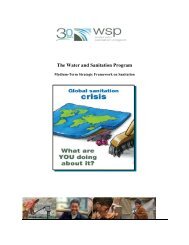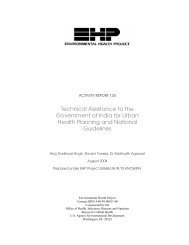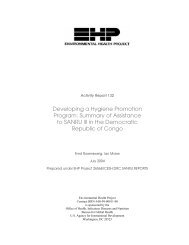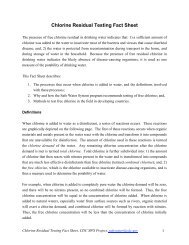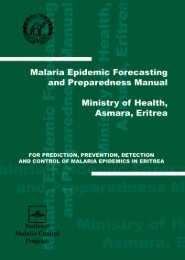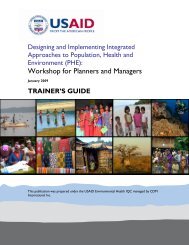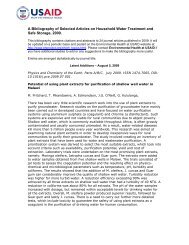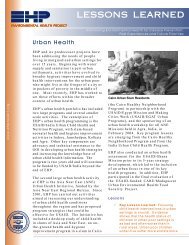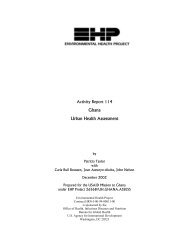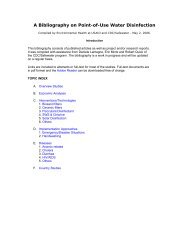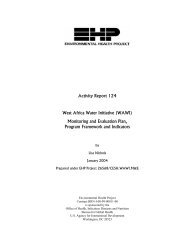Changing Glaciers and Hydrology in Asia - Environmental Health at ...
Changing Glaciers and Hydrology in Asia - Environmental Health at ...
Changing Glaciers and Hydrology in Asia - Environmental Health at ...
- No tags were found...
You also want an ePaper? Increase the reach of your titles
YUMPU automatically turns print PDFs into web optimized ePapers that Google loves.
River Bas<strong>in</strong>) <strong>in</strong>clude southern Kazakhstan, most of Kyrgyzstan <strong>and</strong> Tajikistan, EasternUzbekistan, Western Ch<strong>in</strong>a, Northeastern Afghanistan, <strong>and</strong> a small part ofTurkmenistan. The hotspot conta<strong>in</strong>s about 20,000 glaciers, has an arid clim<strong>at</strong>e, <strong>and</strong> ishome to a highly thre<strong>at</strong>ened type of walnut-fruit forest, unique to this region, whichconta<strong>in</strong>s ancestors of domestic fruit varieties <strong>and</strong> is an important storehouse of geneticdiversity. The hotspot is also home to a rich variety of ungul<strong>at</strong>es, <strong>in</strong>clud<strong>in</strong>g thethre<strong>at</strong>ened argali wild sheep.F<strong>in</strong>ally, the entire region of Southeast <strong>Asia</strong> is a hotspot, cover<strong>in</strong>g all or part of fourmajor river bas<strong>in</strong>s th<strong>at</strong> orig<strong>in</strong><strong>at</strong>e <strong>in</strong> High <strong>Asia</strong>. Unique mammals are still be<strong>in</strong>g discoveredthere, <strong>and</strong> thre<strong>at</strong>ened turtle species <strong>and</strong> over 1,300 different bird species make theirhomes here.Acceler<strong>at</strong>ed glacier melt is only oneof the ongo<strong>in</strong>g changes <strong>in</strong> theseregions, which face many differentpressures, among them the impactsof clim<strong>at</strong>e change.<strong>Environmental</strong> change is alreadybeg<strong>in</strong>n<strong>in</strong>g <strong>in</strong> the high-altitude regionswhere glaciers are plentiful. Forexample, Tibet is experienc<strong>in</strong>gwarm<strong>in</strong>g temper<strong>at</strong>ures, along with<strong>and</strong> generally drier conditions; thel<strong>at</strong>ter is <strong>at</strong> least partially <strong>at</strong>tributableto unsusta<strong>in</strong>able l<strong>and</strong> practices(Khoday 2007).3.5 POTENTIAL GOVERNANCE ANDCONFLICT IMPLICATIONS OFUNSTABLE WATER SUPPLYFigure 3.16. Disputed boundaries (<strong>in</strong> red) <strong>in</strong>volve glaciers <strong>and</strong>w<strong>at</strong>er resources. See Figure 3.1 for country boundaries <strong>and</strong> bas<strong>in</strong>names. Disputed d<strong>at</strong>a source: US Department of St<strong>at</strong>e 2010.Map credit: Brian MelchiorBecause the river bas<strong>in</strong>s span multiple n<strong>at</strong>ional borders, there will <strong>in</strong>evitably be disputesbetween the different n<strong>at</strong>ions over the use of w<strong>at</strong>er with<strong>in</strong> the bas<strong>in</strong>s, despite exist<strong>in</strong>g tre<strong>at</strong>iesth<strong>at</strong> cover various aspects of w<strong>at</strong>er alloc<strong>at</strong>ion <strong>and</strong> rights. Areas like Aksai Ch<strong>in</strong> <strong>and</strong> the SiachenRegions are already disputed areas (see Figures 3.16 above <strong>and</strong> 3.17 on the follow<strong>in</strong>g page).Increased accessibility <strong>and</strong> extraction of w<strong>at</strong>er resources will only exacerb<strong>at</strong>e alreadyproblem<strong>at</strong>ic areas.Governance issues <strong>in</strong> the region will weigh heavily <strong>in</strong> both mitig<strong>at</strong>ion <strong>and</strong> adapt<strong>at</strong>ion actionsrel<strong>at</strong>ed to glacier melt <strong>in</strong> the region. The two largest countries (<strong>in</strong> terms of popul<strong>at</strong>ion,economy, <strong>and</strong> l<strong>and</strong> area), India <strong>and</strong> Ch<strong>in</strong>a, will likely be most <strong>in</strong>fluential <strong>in</strong> clim<strong>at</strong>e-change-rel<strong>at</strong>edpolicies <strong>and</strong> activities. Both of these countries are <strong>in</strong>creas<strong>in</strong>g their greenhouse gas emissions <strong>and</strong>,<strong>at</strong> the same time, emphasize their rights (as non-Annex-1 countries under the United N<strong>at</strong>ions40


